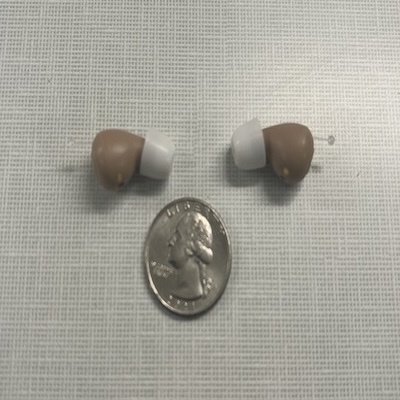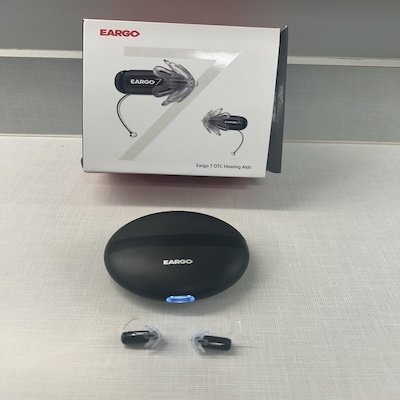Why ELEHEAR is the best for travel
We chose ELEHEAR as “Best for Travel” for its competitive battery life and impressive charging case. The ELEHEAR Beyond (the company’s only model) has a 20-hour battery life (behind Audien’s 24 hours and Jabra’s 24–30 hours), and a fast-working charging case—a quick 15-minute charge powers up your ELEHEAR hearing aids for six more hours of use.
Features
- Bluetooth capabilities: Yes
- How to adjust: Phone app, or buttons on hearing aid
- Trial period: 45-day, risk-free trial
- Warranty: One-year manufacturer’s warranty
Our expert take on ELEHEAR
The ELEHEAR Beyond is an affordable receiver-in-canal hearing aid with an impressive charging case—15 minutes charges your hearing aids for six hours, and your charging case holds four extra charges. With a 20-hour battery life, you could use your hearing aids and charging case for five days without needing to plug them in. This is particularly useful for travelers going somewhere with inconsistent access to electricity.
Our testers loved the Beyond’s comfort and slim profile, especially considering the device’s low price and Bluetooth streaming capabilities (small hearing aids sometimes don’t have enough space to fit Bluetooth technology).
One thing we didn’t like was the ELEHEAR app—while it had lots of good features, our testers found there was a bit of a learning curve and it wasn’t as intuitive as we would’ve liked. However, after some initial confusion, our testers were able to figure it out.
We also didn’t like the buttons on the side of the hearing aid—the volume button is also the on/off button, so it’s easy to accidentally turn off the hearing aids when trying to adjust volume, and vice versa. But again, after some time our testers were able to get the hang of it.
Brands that didn’t make our best OTC hearing aid list
We chose the top OTC hearing aid brands through research and mystery shopping. Find out which others were top contenders but didn’t make our list and why.
- Nano: Nano hearing aids also saw lots of momentum on social media, but we found this brand lacking as well. Although the prices are competitive ($297–$697), only one of the five models has Bluetooth capabilities and an app—you can only adjust the other four models using buttons on the outside of the hearing aid. Also, Nano was sued by the Vermont Attorney General for misleading consumers in 2023. The lawsuit alleges that Nano “ engaged in multiple layers of deception by making misleading statements on its website and in advertisements.”
Why trust Aging in Place
We’ve spent the last four years living and breathing hearing aids. In our research, we’ve:
- Studied 18 brands that make OTC hearing aids
- Surveyed hundreds of hearing aid users
- Tested rechargeable hearing aid models
- Interviewed 5 hearing instrument specialists, 20 audiologists, and tens of real hearing aid users
- Read thousands of verified customer reviews
Read more about how we review hearing aids.
How much do OTC hearing aids cost?
OTC hearing aids vary in price, but generally cost $100–$3,000 per pair, based on our research.
You can save money by opting for simpler OTC hearing aids with less remote support from hearing professionals, but be sure you’re comfortable handling your fitting and adjustments on your own.
What to look for in an over-the-counter hearing aid
When shopping for OTC hearing aids, consider the following important features:
- Style: Do you want something discreet? Or do you prefer something larger so it can fit more advanced technology?
- Features: What features are must-haves for you? Do you need Bluetooth streaming so you can stay connected with hands-free calls? Or do you prioritize advanced sound processing technology?
- How to adjust: OTC hearing aids are not as customizable as prescription devices, but most will have an app that lets you make adjustments. Are you satisfied with simple adjustments you can make by pushing buttons on the hearing aids, or do you prefer an app for adjustments so you can fine-tune your settings?
- Battery type: Hearing aids with rechargeable batteries tend to cost about $200 more than those with disposable batteries. What’s more important to you: cost savings, or the convenience of a rechargeable hearing aid?
- Trial period: OTC hearing aids usually don’t come with the option to see a hearing professional in person, so it’s very important you have enough time to try out the hearing aids and make sure they’re right for you. Look for a trial period that’s at least 45 days.
- Warranty: And because you have fewer options for getting your hearing aids cleaned/serviced in person, a generous warranty can make sure you have options if your devices break due to manufacturer’s defects. A one-year warranty is common for OTC hearing aids.
- Brand reputation: The OTC hearing aid market is still very new. That means there are lots of companies out there—most are good, but there are some bad actors trying to take advantage of confusion over the new OTC landscape. When comparing OTC hearing aids, it’s a good idea to check how long the company’s been in business and whether they have any pending lawsuits.
Where to buy OTC hearing aids
The convenience of OTC hearing aids is that you can buy them without a prescription at big-box stores like Walmart, Walgreens, and Best Buy.
Some hearing clinics do sell OTC hearing aids, but it’s uncommon.
OTC vs. prescription hearing aids






